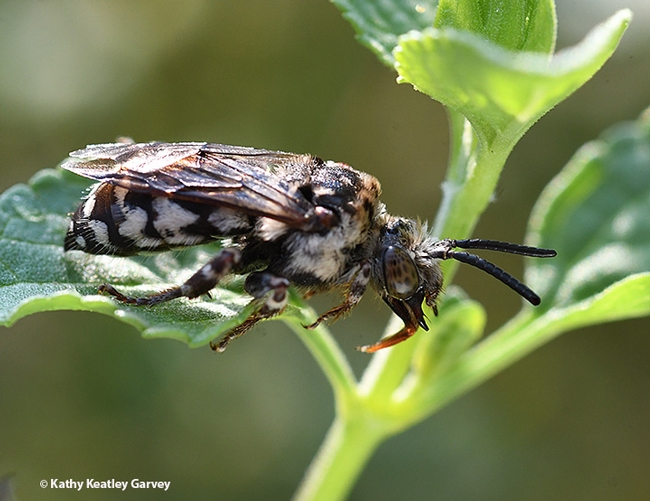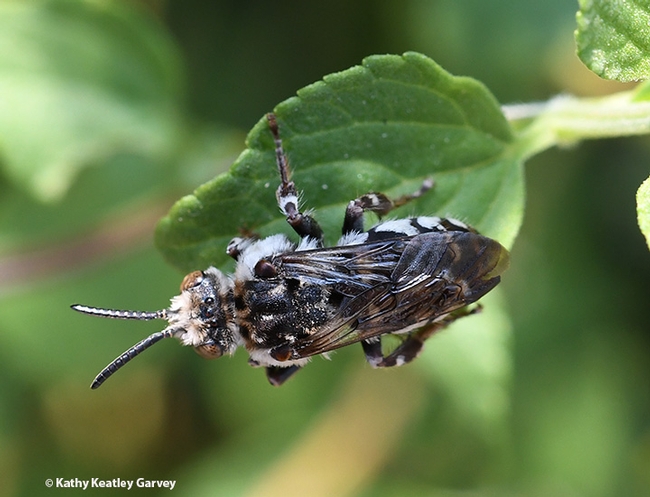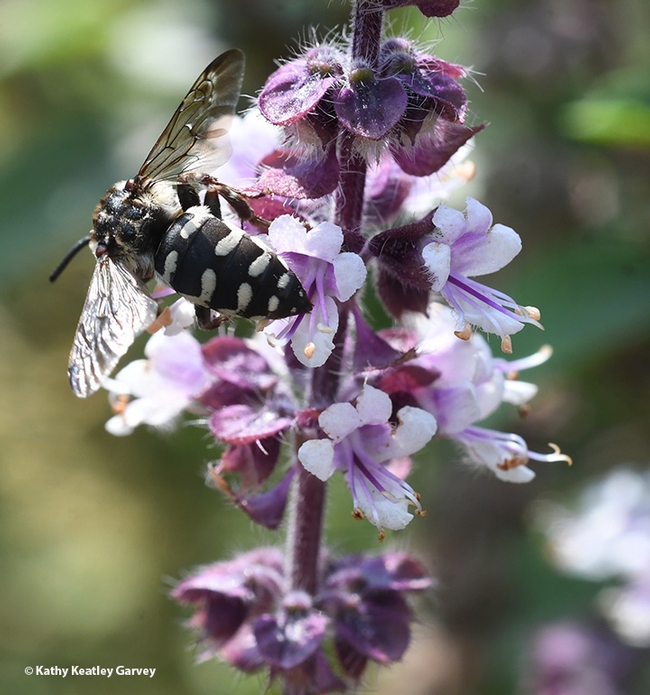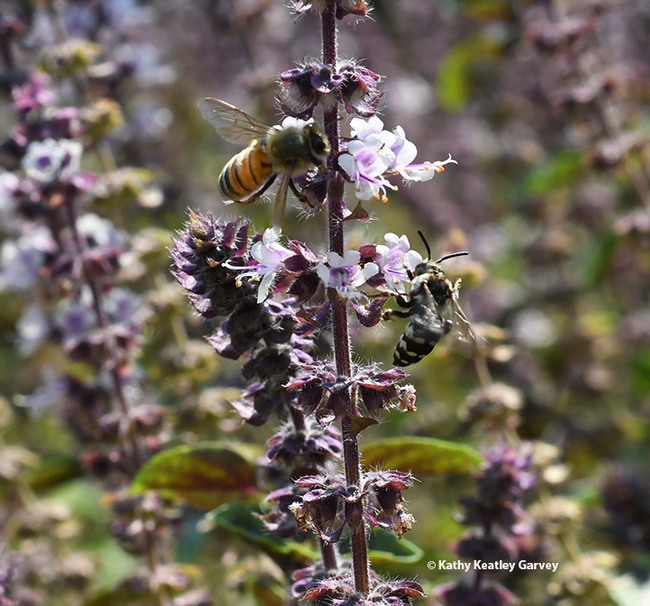UC Gardening Blogs
My Nemesis
My nemesis…Manduca sexta.
Sorry to say, this blog is about 3 weeks late. Let me explain why…
This time of summer, the main tasks in my vegetable garden are the simple things like pulling weeds, checking for signs of adequate water, and harvesting vegetables and herbs to add to mealtimes or share with my neighbors. I have been going just bonkers because I found the telltale signs of a hornworm or two, feasting on my tomato plants: large holes and severe defoliation, devoured flowers, black droppings on leaves, and/or scarring on fruit surfaces. This is absolutely driving me crazy! I inspect my plants early morning and again at dusk, but so far they have escaped detection. It got so bad that I finally conceded to the fact that I had either been outsmarted by a worm or misidentified the pest.
Fast forward to Sunday. While hand-watering one of my tomato plants, right before my very eyes, I spot a very large hornworm! I can't tell you how excited I was to finally be vindicated in my pest identification! (I know, I'm weird).
There are actually 2 different species of hornworms that can devour your garden: the tomato hornworm (Manduca quinquemaculata), or the tobacco hornworm(Manduca sexta).
Both species feed on common garden plants like tomatoes, potatoes, peppers, and eggplants. Looking at my picture, I've identified my pest as a tobacco hornworm: parallel white stripes with dotted black lines lining each of their stripes and a red “horn” on the tail end. In our warmer climates, we are more likely to see the tobacco hornworm devouring our gardens. This pest is very recognizable, but hard to find as they blend in quite easily with the green foliage. Two tomato hornworms can defoliate an entire tomato plant.
Life Cycle:
- The hornworm represents the larval stage of the hawk or sphinx moth, also known as the hummingbird moth. The moths overwinter in the soil as dark brown pupae, then emerge and mate in late spring. They lay their eggs on the undersides of leaves. The eggs hatch in four to five days and the hornworm emerges. It spends the next four weeks growing to full size, after which it will make its way into the soil to pupate.
- It's not uncommon for two or more generations of hornworms to appear in a single season.
So, what to do if you find this pest:
- First, think forward to next season:
- Prior to Spring planting: till you soil. Tilling can kill 90 percent or more of the overwintering pests and reduce hornworm problems for the coming year. When tilling up your garden soil, keep an eye out for hornworm larvae. They look like small, brown torpedoes. Pick them out and drop them in a bucket of soapy water.
- Try interplanting dill or basil; marigolds are also an excellent companion plant.
- Don't plant the same crops in the same place year after year. Crop rotation helps keep all pests off guard. Never plant any type of nightshade varieties in the same place from one year to the next.
- Make your yard a haven for caterpillar eating birds. Set up birdbaths and feeders to enlist the help of these natural predators. Mockingbirds, Robins and other larger, carnivorous, and omnivorous birds are very fond of big juicy hornworms.
- Inspect your tomato plants a few times a day. Carefully look at the stems, as well as the tops and bottoms of the leaves. If you find large, black droppings on a leaf-look above that leaf and you may find your hornworm.
- Once you find one, just pull it off and dispose of it.
I have searched daily for my hornworms. Because it took me so long to find this pest, I'm going try a few organic methods of control:
- My Master Gardener friends have suggested using a black light as hornworms will glow in the dark. I have to give this suggestion a bit more thought, as I don't own a black light, not sure I want to go out and purchase one.
- Diatomaceous Earth. This is a natural product made of tiny fossilized aquatic organisms. It looks like tiny broken pieces of glass on the soil, as predators crawl across it, their body is cut and they will die. This may kill some beneficial insects, but I think the benefits will far outweigh the risks.
- BT (Bacillus thuringiensis). Sprays made with BT are safe for your tomatoes and safe for the insects you want to keep in your garden. (BT is a liquid formulation of bacteria that controls caterpillars, loopers, cabbage worms, hornworms, leaf folders, and leaf rollers. Designed to protect vegetables, fruits, nuts, shade trees, and ornamentals).
· Both BT and Diatomaceous Earth are available at your local hardware store.
Well, enough about my hornworm. Evidence suggests that I have more than the one I found! Wish me luck as I continue the arduous task of finding and removing these insatiable pests.

photo by Erin Mahaney
Master Gardeners Present Free Live Online Workshops
The Master Gardeners are offering our Fall series of free workshops online via Zoom, beginning...
Ever Seen a Cuckoo Bee?
Ever seen a cuckoo bee? They're also called parasitic bees or "kleptoparasites" or...

A cuckoo bee, Xeromelecta californica, rests on a leaf in a Vacaville pollinator garden. (Photo by Kathy Keatley Garvey)

Dorsal view of the cuckoo bee, Xeromelecta californica, in a Vacaville pollinator garden. It flew just after this image was made. (Photo by Kathy Keatley Garvey)

The cuckoo bee, Xeromelecta californica, sipping some nectar. (Photo by Kathy Keatley Garvey)

A honey bee, Apis mellifera, and a cuckoo bee, Xeromelecta californica, sharing African blue basil blossoms. (Photo by Kathy Keatley Garvey)
Beneficial Insects Don't Rest on Labor Day
Beneficial insects can provide a lot of support in the garden. Natural enemies, which include...
Congratulations, UC Davis Distinguished Professor Jay Rosenheim, ESA Fellow!
Jay Rosenheim is a legend around the UC Davis Department of Entomology and Nematology. He's known...

An outstanding teacher, UC Davis Distinguished Professor Jay Rosenheim answers a question in this classroom photo taken in February 2018. (Photo by Kathy Keatley Garvey)



